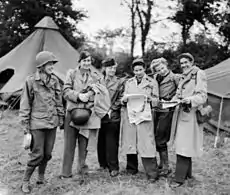Sonia Tomara
Sonia Tomara (26 February 1897– 7 September 1982) was a Russian-born journalist who is regarded as the first female war correspondent of World War II.[1]
Sonia Tomara | |
|---|---|
 Sonia Tomara (second from left) with some female war correspondents during World War II | |
| Born | 26 February 1897 St. Petersburg, Russia |
| Died | 7 September 1982 (aged 85) Princeton Medical Center, New Jersey, United States |
| Nationality | Russian |
| Occupation | Journalist |
| Years active | 1920–1947 |
| Spouse(s) | |
Life
Sonia was born to Michael and Olga Mamontoff Tomara on 26 February 1897 in St. Petersburg, Russia where she graduated with a degree in chemical engineering from the Moscow University for Women.[2] In 1920, she fled with her mother to France during the Russian Revolution where she got employed as a political reporter and editor for Le Matin until in 1928 when she was recruited by the New York Herald Tribune.[3]
During the 1930s, Sonia covered major events including the rise of Adolf Hitler and the battle of France following her return to Europe.[4] In 1940, she returned to the United States after the 1940 armistice.[5] In 1942, she was elected president of the New York Newspaper Women's Club.[6] She was accredited as a United States war correspondent later in the year and was assigned to the Far East to cover political stories in the China-Burma-India Theater.[5] Jean Lyons of the Chinese News Bureau served as acting club president while she was away.[6]
Sonia moved to China in May 1943 where she covered Nationalist Chinese military actions against Japan on the Yangtze River. She later moved to North Africa, covering the Allied Forces Headquarters in North Africa. In 1944, Sonia Tomara returned to Paris and resigned from the New York Herald Times following her marriage to William Clark in 1947.[7]
Death
In August 1982, Sonia was hospitalized after suffering a stroke. She died on 7 September at the Princeton Medical Center, New Jersey, U.S.[7]
Bibliography
- John Hohenberg (1995). Foreign Correspondence: The Great Reporters and Their Times. Syracuse University Press. pp. 153–. ISBN 978-0-8156-2648-0.
- Nancy Caldwell Sorel (1999). The Women Who Wrote the War: The Riveting Saga of World War II's Daredevil Women Correspondents. Arcade Publishing. pp. 59–. ISBN 978-1-55970-493-9.
References
- Nancy Signorielli (1996). Women in Communication: A Biographical Sourcebook. Greenwood Publishing Group. pp. 316–. ISBN 978-0-313-29164-7.
- Judy Barrett Litoff (1994). European Immigrant Women in the United States: A Biographical Dictionary. Taylor & Francis. pp. 298–. ISBN 978-0-8240-5306-2.
- Jean E. Collins (1 January 1980). She was There: Stories of Pioneering Women Journalists. J. Messner. ISBN 978-0-671-33082-8.
- Simkin, John (1997). "Sonia Tomara". Retrieved 3 March 2016.
- Stanley Sandler (January 2001). World War II in the Pacific: An Encyclopedia. Taylor & Francis. pp. 494–. ISBN 978-0-8153-1883-5.
- "Newspaper Women Elect". The New York Times. XCII (31162) (Late City ed.). May 20, 1943. p. 24. Retrieved December 5, 2020.
- "Sonia Tomara Clark". New York Times. 9 September 1982. Retrieved 3 March 2016.